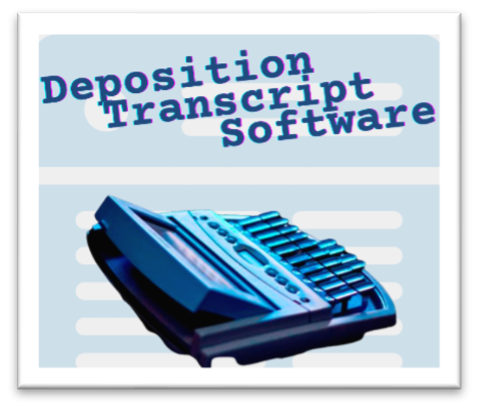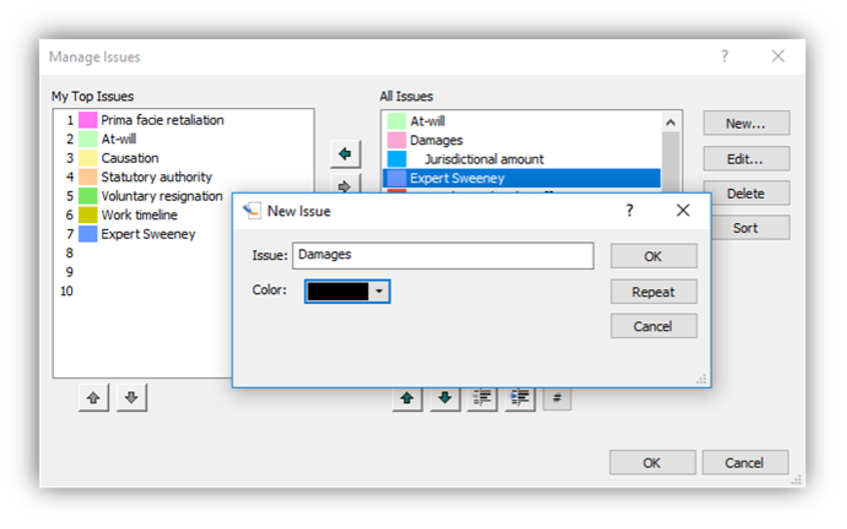[EDRM Editor’s Note: This article was first published here in April 2023 and EDRM is grateful to NALA, for permission to republish.]

Managing the multiple components of the litigation process can be both time-consuming and tedious. While litigation teams use many technology tools, my favorite is deposition transcript software (DTS). Using such software will save time and money. Unfortunately, I have also experienced the pain of quickly finding information from antiquated page/line summaries for the trial attorney.
DTS makes organizing, reviewing, preparing, and presenting deposition transcripts easier. Multiple DTS providers exist, but this discussion will not name or compare them. Instead, I plan to laud the use of this tool for most cases.
Often, deposition testimony is the chief way (and in private arbitration, sometimes there is no written discovery) to identify the issues, facts, documents, and witnesses. This article will focus on the use of DTS to streamline that process.

Westlaw Case Notebook (PTZ) and TextMap (XMEF) transcript delivery formats include hyperlinked exhibits and synchronized video/transcript. Check the DTS to confirm what file format is needed. I use the hyperlinked versions so I can have access to the actual exhibits. My selection allows the reviewers to open the exhibits via hyperlinks directly. There is no need to locate the exhibits by fumbling through folders or searching your document management system.
Organization of the transcripts and exhibits via a DTS system is a simple and effective way to centralize them. In addition, it is easy to run reports for your team. Two of them I frequently use are: (1) a list of all the deposition transcripts and (2) a list of all occurrences of exhibits in the transcript(s).
Setting up the naming conventions of files before importing into DTS will make it easier to sort or locate files. Trial Technologist Alicia Aquino suggest the following:
Steward_Anna_VDT_07_16_2023 (the user can see it was videotaped)
Steward_Anna_DT_07_16_2023 (this is full transcript)
Steward_Anna_CDT_07_16_2023 (this is the mini transcript)
If I don’t have the linked transcript, Alicia Aquino suggests using the bulk rename utility to add the deponent’s name to each respective exhibit (i.e. Exhibit 001 to Steward, Steward 002, etc.)
Review
The first step in this process is importing electronic transcripts into the review platform. The DTS allows for annotation by more than one team member as they review the documents, including leaving notes. The tedious process of reading, reviewing, and annotating deposition transcripts during the pretrial phase is vital. In addition, DTS will allow the coordination of the vast amount of information gleaned from testimony.
We have all had a moment where we remember reading something from a transcript but can’t find that portion of testimony. Annotating the deposition transcripts while you review them allows you to mark portions of testimony by issue or make notes for others to see when they review the same section. The annotations should be tailored to the type of case. For instance, if there were two distinct types of law in a complex litigation matter, you could view the transcripts with annotations regarding only the applicable issues.

The image above provides one example of how issues are set up for an employment-type litigation. You can import the list of issues (via a csv spreadsheet) from your database or case management system.
Prepare
Annotating the deposition transcript during review is an empowering way to gather the details needed for the trial team to formulate a successful strategy. The relevant testimony regarding a document or witness during several sessions can be quickly tagged. It is then easy for the trial attorney to review the relevant portions without searching or reviewing the transcripts again.
For example, if an expert witness for opposing counsel changes his opinion about an exhibit or an issue during trial, the testimony can be located quickly. DTS allows your team additional time to digest this information and confer with the client or expert.
There are multiple types of reports to assist the trial teams. Below is a chart summarizing some report types:
| Report Type | Potential Use | Example of Report |
| Issues | Creating a list of the issues in a litigation (causes of action, matters in dispute, specific allegations) allows for easy information management. | A report of all the annotations in the case for all depositions to date or for a select number of depositions – The content can also be sorted by issue or narrowed to selected items. |
| Witnesses | People rarely use their formal name or full name during their entire testimony. You can annotate all the testimonies regarding a specific witness. | List all of the annotations about witnesses. This report can be essential to an attorney or paralegal outlining examination or cross-examination questions. |
| Key Facts | Annotations regarding key facts can provide details regarding dates, amounts, or specifications. | Facts are also related to issues but are generally straightforward things like dates, invoice numbers, or amounts. Running a full report with all annotations can be helpful. I suggest sorting the report by deponents or issues. |
| Full-Text Search | Locate search phrases or search terms within transcripts. | The report will provide all occurrences of a selected search term or phrase. |
| Designation Lists | Selecting what testimony will be read or played to the arbitrator or jury is painless. | This information is used for meet and confer regarding counter-designations, supplemental designations, or objections. |
Exhibits
The planning, preparation, and presentation of exhibits includes considering multiple items. Knowing what the court or arbitrator requires is the first significant step in the workflow. The other factor that is frequently overlooked is cooperating with opposing counsel on such items as removing duplicate exhibits and exchanging the designation of deposition testimony. Paralegals’ first task is normally to draft the exhibit list. Sometimes the court determines the format of the exhibit list.
Below is an example taken from the San Diego Superior Court forms:

Alternatively, below is an example[1] for a Federal Court Exhibit list:

The standardized naming and detailing of the trial exhibit are the hallmarks of an impressive and useful list. When using electronic exhibits, it is paramount to mark them with both the exhibit and page numbers. Many courts require the page number to be included when branding exhibits. Additionally, you must plan for the requirement to sequentially number each page of the trial exhibits.
As a generic example of requirements, below are two important rules from the Local Rules of the Superior Court of California County of Los Angeles:
| Rule # | Details | Notes |
| 3.52 | All exhibits must be exchanged and pre-numbered, except those anticipated in good faith to be used for impeachment. All exhibits must be pre-numbered before any reference thereto by counsel or a witness. | The date for exchange of exhibits is an important factor. |
| 3.53 | The most efficient method of marking exhibits is the use of arabic numerals in which each party is allocated a block of numbers to be used sequentially. For instance, the plaintiff may be allocated numbers 1 to 200, the first defendant numbers 201 to 400, and the second defendant numbers 401 to 600. Documentary exhibits consisting of more than one page must be internally paginated in sequential numerical order to facilitate reference to the document during interrogation of witnesses. | The use of electronic exhibits makes the numbering easier. |
Present
Many paralegals have dealt with the question of: What should I do with the recording of this deposition? DTS stores the video of the deposition so you can easily access it. For example, creating clips to display witness testimony during a hearing or trial will be necessary. In addition, it is important to consider synching the video to the transcript so that the text can scroll on the screen next to the video.
The judge will require that the counsel meet and confer before a video of deposition testimony is played. Normally, the videotape deposition is permitted to the extent the parties agree on admissibility or edit to resolve objections.
The presentation of evidence during trial includes displaying portions of deposition testimony as well as the exhibits that testimony references.
General Tips for Deposition Transcript/Exhibit Management
I have taken time to include multiple tips because I want everyone to prepare for trial or arbitration with the benefit of some help. The help is in the form of a list, but it can save you valuable time. It will also allow you to think through other potential problems in advance. Some of my favorites: (1) How do I get that 50-gallon drum to the courthouse? (2) Is that government document admissible? Do I need a certified copy of it? (3) Where do I store tangible evidence before it is introduced?
| # | Information / Tip |
| 1. | Use a master deposition transcript exhibit index (This will prevent duplicate exhibit numbers). If all the parties stipulate to use one specific court reporter company that agency would be responsible for creating and maintaining the list. |
| 2. | Don’t use alphabetical identification for deposition exhibit designations. |
| 3. | Number the exhibits sequentially. |
| 4. | Don’t use subparts: Exhibit 104. b or 104(b) or 104B |
| 5. | Set up the issue tags for annotation before the first deposition (Often, the issue tags can be taken from the database coding panel). |
| 6. | Determine the transcript file format needed [a chart regarding transcript file formats is below[i]] and provide that information to the court reporter agency before the first deposition. Make it a standing order for your team or firm. |
| 7. | When the transcript repository (DTS) is set up, offer to provide a short demonstration via Zoom. The team will not learn how to use the system from this demonstration. Instead, the session will provide an overview of the capabilities. |
| 8. | Email the team about access to the repository, and include a document listing the issue tags and a simple instruction guide. |
| 9. | Keep a tracking list for the deposition transcripts that includes multiple categories, such as whether it was videotaped, exhibit numbers, the designation number of prior exhibits reused, the attorney who attended, details regarding the witness, date, time, and volume. |
[i] Transcript File Formats
| TYPE | DETAILS |
| LEF | LEF is a file format that enables you to receive transcripts with the related evidence seamlessly integrated and ready for import into LiveNote. A LEF file can contain all the deposition exhibits already scanned and hyperlinked into the text, ready for import into LiveNote. |
| PTX | RealLegal™ E-Transcript™ file (Referred to frequently as an E-Transcript) |
| PTZ | RealLegal™ E-Transcript™ Bundle Viewer (exhibits) |
| TextMap(XMEF) | This software is provided to court reporters, vendors, and law firm staff to create TextMap Exhibit Packages (.xmef), which you can import into TextMap. In addition, DTS simplifies adding hyperlinked exhibit files to an ASCII or PTF text file of a deposition or other transcript. |
| TXT/ASCII | TXT/ASCII only retains the transcript. |
| CMS | NativeTrial Director |
| MDB | A synchronized transcript database is created with Sanction and the corresponding .mdb (Exhibits are usually retained). |


